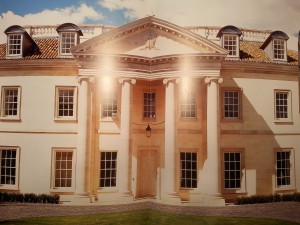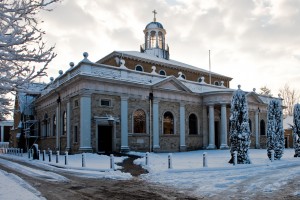Quinlan Terry, born in 1937, is a British architect well known for his use of Classical architecture throughout Britain and the United States. 1 Despite being educated at the Architectural Association in the Britain in modernism, Terry rejected Modernism, explaining that with Modernism “the ability to design and build beautiful buildings has ceased.” 2 3 Terry’s opinion on Modernism is due largely to his religiosity, believing that “modern man fears no God and has no hope beyond technology” whereas the “ancient man harnessed nature and expressed it in his art.” 4
Terry was awarded the Richard H. Driehaus Prize for Classical Architecture in 2005, a prize which rivals the Pritzker Prize, which was typically seen as a Modernist prize. 5 Having only been established a mere two years before Quinlan Terry’s victory, the Driehaus Prize was largely established because of Terry, as his contributions to Classical architecture helped push forth the movement in both Britain and the United States, which eventually led to him expanding his influence out to even Germany, solidifying him as one of the the greatest Classical architects of the time. 6 Apart from this, by deviating so heavily from the accepted norm and making a name for himself and his style, Quinlan Terry, with the help of several others such as his mentor Raymond Erith, formed and maintained a movement away from Modernist architecture and towards more Classical roots with moderate success, exemplifying precisely how important Terry was to architecture as it now stands.

Architect: Quinlan Terry
Location: Dallas, Texas
Photo by: Dan Piasik
The Highland Park House (figure 1), completed in 2004, is largely indicative of Terry’s style. The Ionic porticoes in figure 1 supporting the pediment is a call back to Classical architecture, heightened by the use of Texan limestone and the finish in Moleanos marble. 7 Specifically, the use of Texan limestone is important, as many architects at this point were taking advantage of the availability of non-local materials, but Terry believed that “local materials should be used whenever possible,” which naturally coincides with Classical styles as there was little option for outside sources. 8 Brentwood Cathedral (figure 2) succeeds in mimicking Classical styles in not only materials, but also in the fenestration being composed almost uniquely of round-topped, or Palladian, windows and the ornamentation of the building, which to Terry was of utmost importance. 9

Architect: Quinlan Terry
Location: Brentwood, UK
Photo by: Tomas
-SR
Figure 1: Dan Piasik, Highland Park House. Taken from: David Watkin, “Radical Classicism: The Architecture of Quinlan Terry”, (New York, Rizzoli International Publications, Inc., 2006), 194 – 195
Figure 2: Tomas, Brentwood Cathedral, December 18, 2009. Available from: Flickr, link (accessed November 24, 2015)
Notes:
- “Introduction”, accessed November 24, 2015, http://www.qftarchitects.com/introduction/ ↩
- Charles Jencks & Karl Kropf, “Theories and Manifestos of Contemporary Architecture”, (Chichester, England, Academy Editions, 1997) 193 – 195 ↩
- Richard Economakis, “Architectural Monographs No. 27: Quinlan Terry: Selected Works”, (London, Academy Editions, 1993), 7-8 ↩
- Jencks & Kropf, “Theories and Manifestos” ↩
- David Watkin, “Radical Classicism: The Architecture of Quinlan Terry”, (New York, Rizzoli International Publications, Inc., 2006), 9 – 10 ↩
- Ibid ↩
- Watkin, “Radical Classicism”, 192 ↩
- Economakis, “Quinlan Terry: Selected Works” ↩
- Watkin, “Radical Classicism” ↩
